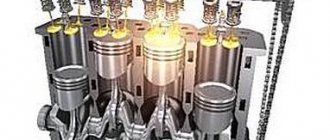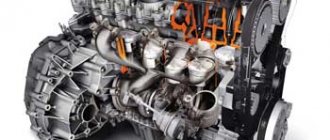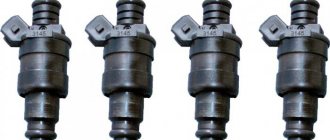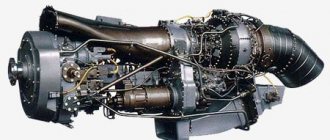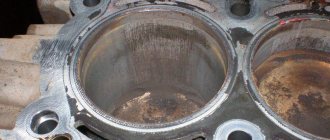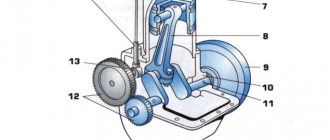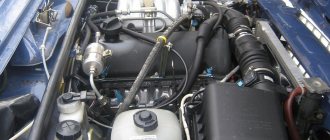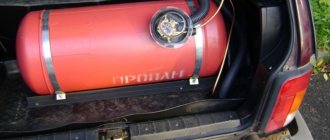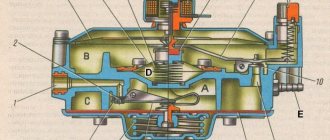Installation of HBO
Gas engine and gas diesel.
14.03.2017
Technologically, there are two options for converting diesel cars to run on gaseous fuel. The first method is to depower the engine and convert it from diesel to gas. The advantage of this method is excellent economic performance and maximum environmental effect.
Converted cars with the ADIS system to a gas engine showed that the car's consumption, compared to a diesel engine, remained at the same level and amounted to 25 cubic meters of LNG instead of 25 l/dt. Accordingly, environmental indicators were optimal, harmful emissions into the atmosphere decreased by up to 90%. But the disadvantage of this method is that a gas engine cannot run on diesel fuel, and you can return the engine to diesel mode if you incur some costs, usually comparable to the cost of a major engine overhaul.
And the second, more common and simpler method is gas-diesel, in which case no changes are made to the engine design. The engine is equipped with gas equipment and a system for limiting the supply of diesel fuel, up to 25% - 35% of the nominal. At the same time, harmful emissions into the atmosphere such as soot, hydrocarbons, CO, benzopyrene, nitrogen oxides, etc. are reduced to 90%.
In this case, we have a slightly smaller economic benefit, replacing not 100% of diesel fuel with gas, but approximately 70%, but it is much easier to convert a car in this way, without making any changes to the design, leaving the diesel mode and adding another engine operating mode - GAS DIESEL , which turns on without stopping the engine by simply pressing a button on the car’s dashboard.
In this case, we have excellent economic efficiency combined with unique emissions! The ignition dose (30% of the nominal amount) of diesel fuel supplied to the cylinder always burns out completely, forming a minimal amount of soot and other harmful substances, compared to the diesel engine operating mode. About the system The “Gazodisel” system is a universal system designed for converting diesel engines to run on all types of gas fuel: CNG (compressed natural gas), LPG (liquefied petroleum gas), biogas, compressed natural gas, hydrogen. The advantage of this system over all analogues on the market is:
- controlled gas supply with phased injection (separately into each cylinder).
- The calculation of injection time and ignition angle (for gas engines) is set according to the algorithm you have specified and is controlled by the ECU.
- the most effective gas supply control algorithm controlled by a computer with protection against all possible errors: all system components are controlled by the ECU with instantaneous interruption of gas supply in case of errors, which makes the operation of the ADIS system as safe as possible
- the ability to update the firmware of the ADIS control unit without replacing it, in the event of developing new software.
- the ability to individually configure this system for the temperature conditions of each region, terrain and transportation characteristics.
The system we use meets the standards of the 4th generation of HBO. It differs from its analogues in the gas-diesel systems market (which operate at the level of the second generation of gas-diesel systems), by separate injection and electronic control of the operation of the entire system, including control of the operation of the diesel fuel supply limitation system, with multi-level protection of the engine and system from failures and critical factors inherent to previous generations.
One of the most important advantages of using gas fuel is the economic feasibility of using gas fuel, most clearly expressed by a reduction in transportation costs by 2-4 times (for example, there are countries where the ratio of the price of natural gas to diesel fuel is one to five). In most countries, the average price ratio of diesel fuel to gas is one to two.
Below is an example for a truck with a consumption of 40 l/100 km. mileage When converting it to a gas engine, instead of 40 liters of d.t. it will consume up to 40 m3 of compressed natural gas, or up to 44 liters of liquefied petroleum gas in the case of a propane-butane mixture.
If we convert the same car to gas-diesel, we will get:
instead of a consumption of 40 liters. D.T. —> 12 l. D.T. + 28 m3 CNG (compressed natural gas) or 20 l. D.T. + 20 l. LPG (liquefied petroleum gas).
Diesel car running on compressed gas - methane
Installation of gas cylinders for methane on a BELAZ mining dump truck
LPG for diesel: about installation methods
Today, there are two main ways to install gas equipment on a car running on diesel fuel. One of them is very radical and is used extremely rarely, however, you should know about it.
We are talking about inserting classic spark plugs into the cylinder head. This will create a spark, which in turn will ignite the gas. In addition, diesel injectors can be replaced with spark plugs if space permits.
If not, then plugs are installed in place of the diesel injectors, and the integration of the gas injection system is carried out in the intake manifold. In this case, to reduce gas compression, it is necessary to install a thick gasket between the head and the cylinder block.
All these modifications affect not only the fuel system of a diesel car, but also its electronics and wiring. As a result, the diesel engine essentially ceases to be itself and turns into something else.
The second option is much simpler, practical and economical, and it consists in integrating gas equipment into a diesel engine, but only if its design is as close as possible to the design of gasoline analogues. In this case, there is no need to change anything in the ignition system, since the ignition of gas fuel occurs from compression, just like the ignition of diesel fuel. In this case, the gas fuel is a mixture of propane and butane, or compressed natural gas - methane. It is noteworthy that the use of natural gas is more profitable than a mixture of propane and butane, since methane is cheaper. In addition, natural gas can replace diesel fuel by 80 percent.
Gas equipment for engine
A gas "spider" climbed into the engine compartment of a gasoline engine. A gas "spider" climbed into the engine compartment of a gasoline engine.
I myself drove cars with gas equipment for about 15 years, and installed it myself. But these were carburetor cars, where all settings could be made without special equipment. I was not involved in registration and never did pressure testing of cylinders. In those days there were simply no mechanisms for such verification. And now certification is mandatory, without it you won’t be able to fill the car, without it you won’t be given a diagnostic card. No wonder those years were called the dashing nineties... Nevertheless, I went and was happy. And this was in Moscow, although it happened to travel around the country.
Results
I will express my personal opinion. For the first seven years after graduating from university, he was involved in testing and fine-tuning diesel supercharged and naturally aspirated engines. I had in personal use a bunch of domestically produced carburetor cars, many of which (from UAZ-469 to Tavria) I installed gas equipment on. While working in a publishing house, I drove many cars of domestic and foreign production. And I concluded for myself that there is nothing better than a naturally aspirated gasoline engine with fuel injection and a timing chain drive instead of a belt. The most hassle-free option! And it makes sense to install diesel engines on fairly heavy SUVs, pickups, delivery vans, small trucks and further down the list, right up to long-haul tractors.
Petrol, diesel or gas - which engine is better?
Payment for HBO 10%
Increasing state subsidies for natural gas motor fuel.
New information has appeared (news statement dated June 16, 2020) that 60% of the costs of switching vehicles to LPG are now paid by the government.
Energy Minister Alexander Novak explained that compressed natural gas (methane) is an environmentally friendly and economical type of fuel. Therefore, the government’s task is to support the gas engine industry.
From 2021 to 2024, the government will actively finance this area. In total, the state plans to invest 50 billion rubles. To re-equip one car, it takes from 80 to 150 thousand rubles. Alexander Novak predicts that new increased subsidies will make this procedure more accessible. Doubling the size of subsidies will make the transition to CNG feasible for 10-12 thousand cars already in 2021.
Government subsidies for converting vehicles to gas now cover 60% of costs instead of 30%. This applies to both individuals and legal entities. These subsidies significantly reduce the cost of converting a car to LPG. Now is the best time for this!
Is it profitable?
If a gasoline engine runs entirely on gas, the cost of fuel costs is exactly halved.
Under favorable conditions, the payback of diesel gas equipment will occur in 70-100 thousand kilometers. And only after this mileage will you start saving. That is why gas is installed on a diesel engine only in rare cases, and only on domestic trucks. Such a system is practically never found on passenger cars.
Requirements for gaseous fuels
- ensuring good mixture formation;
- high caloric content of the combustible mixture;
- absence of corrosion and corrosive wear;
- minimal formation of deposits in the intake and exhaust tracts;
- maintaining quality during storage and transportation;
- low cost of production and transportation.
Benefits of using gaseous fuels
The octane number of gas fuel is higher than that of gasoline (the average octane number is 105), therefore the knock resistance of liquefied gas is greater than that of even the highest quality gasoline.
This allows for greater fuel efficiency in an engine with a higher compression ratio. At the same time, the combustion rate of gas is slightly lower than that of gasoline. As a result, the load on the cylinder walls, piston group and crankshaft is reduced, which allows the engine to run smoothly and quietly.
The gas mixes easily with air and fills the cylinders more evenly with a homogeneous mixture, so the engine runs smoother and quieter. The gas mixture burns completely, so no carbon deposits form on the pistons, valves and spark plugs.
Gas fuel does not wash away the oil film from the cylinder walls, and also does not mix with the oil in the crankcase, thus not worsening the lubricating properties of the oil. As a result, cylinders and pistons wear less, and the frequency of engine oil changes increases.
Compared to gasoline, liquefied gas has the following advantages:
- one and a half to two times less cost;
- higher detonation resistance (octane number 105);
- a gas engine runs smoother, and its service life increases by about one and a half times;
- the frequency of engine oil changes increases by one and a half to two times, since its aging period decreases;
- the service life of spark plugs increases by 40%;
- the gas contains practically no sulfur, which causes corrosion of metals and their wear;
- the toxicity of exhaust gases is reduced (CO by half, CH by 50...100%, NOx by 20...30%);
- unlike gasoline, the gas mixture is more homogeneous in composition;
- Resinous deposits do not accumulate on parts and devices of the power supply system, since petroleum gas dissolves them;
- Carbon formation on engine parts is significantly reduced.
Compressed natural gas compared to liquefied petroleum gas has the following advantages:
- greater safety, since it is lighter than air and evaporates in case of leaks;
- cheaper;
- large natural reserves;
- exhaust gases are more environmentally friendly.
Flaws:
- lower combustion rate compared to gasoline, as a result of which engine power is reduced by approximately 7...12% (up to 20%);
- difficulty starting the engine at low temperatures;
- an increase in the vehicle's metal consumption by 25...30 kg with liquefied gas and by 700...800 kg with compressed gas;
- the use of additional expensive equipment leads to an increase in the cost of the car by 20..27%;
- increased gas consumption compared to gasoline;
- the need for periodic inspection of gas storage cylinders at testing stations;
- the labor intensity of engine maintenance and repair increases by 3...5% (these costs are offset by savings from increasing the overhaul life of engines);
- the travel range at one gas station does not exceed 200...250 km;
- increased safety requirements when using gas cylinder installations.
Liquefied gas is commonly used in passenger car engine power systems. Converting a car to run on liquefied gas is easier and cheaper than converting it to run on compressed gas. In addition, liquefied gas is in a cylinder under relatively low pressure (approximately 1.6 MPa), and the high degree of rarefaction of compressed gas requires increasing this figure by 12-15 times.
The principle of operation of a gas diesel engine
Today, gas diesel can be installed in two ways - completely converting the engine to gas power, or organizing a combined engine power system.
- The first method involves a thorough modernization of the engine, since the octane number of methane is only 120 - the standard diesel compression ratio for it is high, which creates a risk of detonation. In this case, the detonation ratio is reduced to 12:1 or 14:1. In addition, the ignition temperature of gas is 700 degrees, while a diesel engine has only 380 degrees - the gas cannot ignite, so it needs a spark ignition system (as in gasoline engines). An already modernized engine cannot be converted back to diesel fuel.
- The second method is simpler and cheaper - the main fuel will be diesel fuel, but part of it will be replaced by gas (methane or propane). In this case, diesel fuel acts as a igniter for the mixture of fuel and air, which creates a charge to ignite the gas. Depending on the load on the fuel equipment and the engine, the degree of replacement of the main fuel with additional fuel is determined. Today, it is possible to achieve a replacement level of 50 percent or more for methane, as well as 30 percent or more for propane.
What is the advantage of gas diesel?
- Easy to install - the equipment set is universal, so it is suitable for any diesel engines (including modern models). Installation does not require engine disassembly or modifications, and you can switch back to diesel at any time - just activate the switch in the cab.
- The efficiency and service life of the engine increases - gas increases power and torque (with turbocharging, the figures increase by 30%). The engine runs smoothly and quietly, reducing the load on the diesel fuel supply system, which extends its service life.
- Economical and environmentally friendly - by replacing diesel fuel with gas, you can reduce the cost of operating a vehicle by 20 percent, as well as reduce the amount of exhaust gases - this improves the environmental performance of the engine.
Difficulties of completely switching from diesel to gas
We have already listed the difficulties above, so we will present them more briefly:
- The ignition temperature of diesel fuel and gas is different.
- The compression ratio in a diesel engine is not enough to heat up the gas mixture - third-party spark plugs are needed.
- The octane number of gas and diesel fuel are different - the compression ratio needs to be adjusted, or the octane number in the gas needs to be reduced.
Dual Fuel system and how does it work?
The combined fuel supply system is the most affordable and easy-to-install option - ignition of methane or propane occurs due to diesel fuel, and the main components of the system are a gas reducer, hoses and lines, as well as storage cylinders. When organizing such a system, the engine is started on diesel fuel, and then the gas reducer is connected - it supplies the mixture to the combustion chamber through the intake valve. A mixture of gas and oxygen is mixed with a small dose of diesel, which ignites and ignites methane or propane. This allows you to obtain constant engine efficiency with a reduced portion of diesel fuel.
Both propane and methane systems are allowed for installation in diesel engines, but there are some difficulties. The percentage of propane in the mixture does not exceed 50%, and in the case of methane 60% - this reduces the portion of diesel fuel supplied to the combustion chamber, which has a positive effect on efficiency. However, it is impossible to completely remove the supply of diesel fuel, since the mixture will not ignite.
How profitable is this?
By converting the engine to gas fuel, fuel costs can be halved. Favorable operating conditions allow you to fully pay for the installation of gas equipment on a diesel engine in 70-100 thousand kilometers, and then start saving. That is why such systems are more common on trucks than on cars.
Requirements for gaseous fuels
- Ability to ensure good mixture formation.
- The ability to create a high-calorie combustible mixture.
- No corrosion.
- Minimum level of deposit formation on the exhaust and intake tracts.
- The ability to maintain its quality during transportation and storage.
- Affordable price for production and transportation.
Gas as a fuel and its advantages
The high octane number of gas allows for greater resistance to detonation than the highest quality gasoline. Engines with a higher compression ratio can achieve much greater efficiency, and a lower gas combustion rate reduces the load on the cylinder walls, crankshaft and piston group. The gas easily mixes with air, so it fills the cylinders evenly - the engine starts to run quieter, and complete combustion of the gas does not leave carbon deposits on the pistons, valves and spark plugs. The use of gas fuel helps stop the washing off of the oil film on the cylinder walls, which does not impair the lubricating properties of the oils - wear on the pistons and cylinders becomes less, and the oil can be left without changing for a longer time.
If we compare natural gas and gasoline, gas will have the following advantages:
- Lower cost.
- High resistance to detonation.
- Increased spark plug life and oil change intervals.
- Almost complete absence of sulfur, which causes corrosion.
- Reducing the toxicity of exhaust gases.
- More homogeneous composition.
- No accumulation of tar deposits.
- Reduced carbon formation.
Comparing natural gas and oil gas, we can talk about the following advantages of the first:
- Increased safety - disappears during leaks.
- Affordable price.
- Huge reserves in nature.
- Cleaner exhaust gases.
However, natural gas also has some disadvantages:
- Reduced internal combustion engine power due to a reduced combustion rate.
- Difficulty starting at sub-zero temperatures.
- Increasing metal consumption of the car.
- Increasing the cost of a car due to the use of expensive equipment.
- Higher consumption.
- The need to periodically inspect storage cylinders.
- More difficult process of engine maintenance and repair.
- The travel range at one gas station is no more than 250 kilometers.
- Increased safety requirements when using HBO.
The benefits of our gas-diesel technology
- Replacement of diesel fuel 60-70% in a mixed operating cycle.
- Possibility of conversion of any diesel engines, including COMMON RAIL EURO-4.
- Possibility to use both types of fuel: diesel and gas.
Gas diesel: scientific and educational film about technology
Gas to diesel: operating principle
*% replacement is in the range of 45-80%
| Total |
| Savings per 100 km, rub. |
| Savings per year, rub. |
| Savings over the life of the vehicle, rub. |
Replacement coefficient when using gas equipment on diesel engines
The electronic unit in the diesel gas equipment controls the fuel supply and controls the process of diesel substitution, which reaches 80% (peak substitution).
The replacement coefficient is calculated dynamically depending on engine operating parameters: speed, load, fuel pressure, turbine boost pressure; and is adjusted according to numerous factors: engine detonation, engine and incoming air temperature and other factors.
The software package allows you to achieve accurate calibration of engine operation in gas-diesel mode.
Pros of converting diesel to methane
- Easy to install. Installing LPG on a diesel engine is suitable for all types of engines, and there is no need to completely modernize the engine of your car.
- Economical. Switching to gas-diesel systems becomes 35% more economical for you than maintaining a car only on diesel fuel.
- Environmentally friendly. Converting diesel to gas, especially methane, increases the environmental friendliness of the engine, thereby reducing exhaust emissions into the atmosphere.
- Reducing the noise level during vehicle operation.
- Increased service life of the diesel fuel supply system.
- Converting diesel to methane increases engine power by up to 30%.
- Increased power reserve. Indeed, in addition to an additional tank with diesel fuel, there is also a gas cylinder. A gas diesel engine can travel three times further without refueling.
About automobile gas equipment
Gas-cylinder equipment must ensure safe storage, supply, as well as full operation of internal combustion engines using “blue” fuel. As we know, methane or propane-butane is used for cars. The first is in a compressed state, the second is in a liquefied state.
After switching the car to gas, the main type of fuel is used as usual. The factory power supply system does not change much during the installation of gas equipment; to a greater extent, it is only supplemented with special units for gas. As a result, the equipment is capable of operating on both types of fuel with separate or even simultaneous supply. The combustion of the gas-fuel mixture occurs according to the same physical laws as when working on the main fuel. You can learn more about the operation of the equipment by reading the article “GBO for a car.”
What is needed to install gas equipment on diesel?
- Control block. The main one in this system. It consists of controllers and controls the operation of the kit.
- Fuel pump. One of the most important components. Necessary for fuel supply. If you use gas, you will have to convert it.
- Reducer-evaporator. In cylinders, propane is in liquid form. An evaporator reducer is needed to turn it into gas. Methane is already in gas form, but a reducer is still needed to maintain pressure.
- Gas injectors. Necessary to pass gas into the combustion chamber.
- Fuel switch. It is needed so that the driver can manually change the fuel at will.
- Temperature, synchronization, gas sensors and others. Needed for the engine. Used to create a mixture.
- Gas cylinder. Quite large in size. This is where the gas is located.
- Highway. This is the tube through which gas flows from the cylinder to the engine.
- Refueling devices. Required for gas refilling.
- Multivalve. It is necessary that the gas can enter and exit the cylinder.
- Protective equipment. Needed to protect the cylinder from overfilling and to relieve excess pressure.
- Filter. Responsible for purifying gas from impurities and debris.
As you can see, LPG on a diesel engine has many advantages. It is indispensable for trucks and large equipment.
What is included in the LPG kit for diesel?
Installing LPG on a diesel engine of a passenger car is quite costly; it is more expedient to convert trucks. Methane is more profitable as a fuel, it is more economical, the weight of a thick-walled gas cylinder does not have a significant effect on the power characteristics of trucks, this is the difference from cars.
The diesel gas installation kit consists of the following elements:
- Containers for gas fuel (one or more). The heaviest and largest part of the system. If a cylinder for a propane-butane mixture is light, then for methane it is quite heavy. Natural gas is under high pressure and increased demands are placed on the strength of the tank walls.
- The gas solenoid valve is a key element of the gas equipment, which plays the role of a shut-off device when supplying and shutting off gas to the evaporator reducer.
- Reducer-evaporator. Methane is in gaseous form in the tank. In order to use it as automobile fuel, it is still necessary to install an evaporator reducer. The coordinated activity of the entire system directly depends on its quality.
- Gas injectors, which are selected based on parameters such as performance, response speed, and maintainability. Injectors supply fuel to the firebox.
- Electronic control unit. Analyzes parameters and manages the activities of all gas equipment. ECUs from well-known brands work perfectly on modern cars thanks to a set of various adaptations and smart on-board diagnostic programs for the vehicle. Modern ECUs are configured automatically, with a minimum of human intervention.
- It is necessary to install temperature, speed, and gas fuel pressure sensors to help the ECU to ensure trouble-free operation of the machine when switching to LPG.
- Diesel injectors. Without them, it is impossible for diesel fuel to enter the fuel chamber.
- The fuel pump is required by the diesel system. The most important element of gas equipment, the performance of a vehicle running on diesel fuel depends on it.
- A toggle switch or button that allows you to switch the car from one type of fuel to another is installed on the panel in the car in a place convenient for the driver.
- Gas pipeline, through which gas flows from the storage tank to the reducer.
- Multivalve. It stands on a gas tank and acts as a shut-off valve, ensuring the flow of gas into the gas tank and supplying it to the engine compartment.
On a note! No matter the quality of the fuel, gas filters are required. First, they roughly clean the gas mixture, then perform a fine cleaning of the gas fuel just before it enters the engine compartment.
Retrofitting methods
There are 2 main ways to install gas equipment on a diesel engine.
- Complete refurbishment of the internal combustion engine. This allows you to completely abandon diesel fuel. But drastic changes have to be made. Here you need to change the compression ratio, install an ignition system, etc. In total, this will cost at least 200 thousand rubles. At the same time, the engine’s power and torque ratings will drop.
- Application of the Dual Fuel system. This is a dual-fuel system in which diesel fuel and gas are used in certain proportions. Modernization costs up to 100 thousand rubles.
It is the second method that is most widespread.
Installing LPG on a diesel engine in a car service center
Not all companies specializing in the installation of automotive gas equipment take on such orders. Only those who have certain knowledge, experience in this area and technical capabilities for re-equipment agree. And if the question concerns heavy equipment, there are even fewer competent specialists.
We talked about how to choose the right installer here.
But regardless of whether it is necessary to install LPG on diesel trucks, passenger vehicles or agricultural equipment (tractors, etc.), with the proper approach, the economic effect will be obvious .
Where should it be installed
As already noted, installing gas equipment on a diesel engine is highly complex. Therefore, this is a job for specialists who understand the intricacies of the issue. The installer must be licensed, and the list of works includes setting up and testing gas equipment. The installer will complete the necessary documents for registration and will subsequently perform periodic maintenance and inspections.
It may seem that installing a gas diesel engine differs little from the usual one. But we note that some work in garage conditions is impossible to perform efficiently. It's about setup, first and foremost. This cannot be done without a special stand.
Advantages and disadvantages
When converting a car to gas, significant benefits arise:
- Savings on fuel consumption. Propane-butane consumption is 18-20% higher, but its cost is almost 2 times lower than gasoline. The savings are felt when the car is actively used, if the mileage is more than 15,000 km per year.
- The parallel use of gasoline and gas is especially valuable for drivers who travel long distances. This results in a double power reserve. The risk of refueling a car at a gas station that supplies poor quality fuel is reduced. On the highway they usually switch to gasoline, in populated areas - to gas fuel.
- A gas turbo engine runs quietly and smoothly because the octane number of the gas is higher. As a result, possible vibrations are reduced. In Europe, great importance is attached to reducing noise pollution on city streets.
- On gas, ignition in an internal combustion engine is more efficient. The gas mixture burns out more slowly and more evenly. The load on the piston group is less. Less detonation. Reduced wear of parts. The answer to the question whether it is possible to install gas equipment on a turbocharged engine without causing damage to the car is positive.
- The gas mixes evenly with air and does not smoke. The engine oil becomes cleaner and the viscosity level remains longer. The oil film protects the cylinder walls. The total time between overhauls of the engine increases.
- When the turbo operates on gas, tar does not accumulate, and there is less soot on the spark plugs. The service life is up to 40% longer due to the hydrogen content in gas fuel.
A gas car is more environmentally friendly. Gas fuel is less toxic. Its use means a reduction in emissions into the atmosphere. No harmful impurities are added to the propane-butane product. In terms of environmental friendliness, gas fuel is inferior to electric vehicles and hydrogen engines.
There are also inconveniences when switching a turbocharged car to gas fuel:
- The combustion rate of gas is lower than that of gasoline, so a drop in car power of up to 15% will not help you. In practice it is not noticeable. Only an experienced driver can notice the difference during strong acceleration. Modern gas equipment reduces this difference in the power characteristics of turbocharged engines to zero.
- The fact of re-equipment leads to the need for service. If you do everything correctly from the beginning, refuel with high-quality gas, the costs will be minimal. The only action is to replace the filter every 15,000 km. mileage
- The weight of the car increases, the capacity of the trunk decreases if a gas tank is installed there. The cylindrical one takes a lot, and because of the toroidal one you have to drive without a spare wheel.
- Underground parking lots do not always allow cars with gas equipment to be parked on their premises. Propane-butane lingers in the room. It is not advisable to park a car with propane-butane fuel in a garage where the inspection hole is open.
- HBO must be registered. A document for HBO and a car repair shop license are required. Self-installation of gas equipment is excluded.
The disadvantages include the expense of purchasing and installing gas equipment. Consider the issue of refueling with gas fuel. Not all areas have problems with this.
It is up to the car owner to decide whether to convert a car with a turbo engine to LPG or not. The benefits are obvious, and they are associated with significant savings on fuel, extension of the service life of the internal combustion engine and environmental friendliness. To reduce the negative aspects, you need to choose good equipment and perform proper setup at a car service center that you can trust with your car.
Read further:
Is it possible to put gas on a turbocharged engine?
Installing LPG on a diesel engine: what does it look like in practice?
The engine stalls on gas: what is the reason and what to do?
HBO for Polo sedan: how to do it correctly?
Everything you need to know about installing gas equipment on the Lada Largus
Gas diesel: pros and cons
A significant argument in favor of installing LPG on a diesel car is, of course, a significant reduction in the cost of refueling the car. If a diesel car is often driven outside the city, at “decent” speeds and at high revs, then fuel savings can be up to 25 percent.
If we consider the “cons”, then we should note the relatively high cost of both the gas equipment itself and the professional services of the craftsmen who install this equipment. In this regard, the payback period will depend on the intensity of use of the gas-diesel vehicle. In addition, gas equipment may fail and its parts will require replacement, which indicates possible additional costs.
In other words, before installing LPG on your diesel car, you need to carefully weigh the pros and cons, and only after that make a final decision.
Gas for diesel engine
So, the active development of gas injection systems has led to the emergence of the fifth generation of gas injection systems. This scheme makes it possible to implement liquid phased distributed injection. The solution is suitable for installation on any fuel-injected cars, easily integrates and is compatible with OBD and EOBD on-board diagnostic systems.
In the case of a diesel engine, this scheme is also taken as a basis, allowing a modern turbodiesel to operate on liquefied gas. As a result, such an engine is often called a gas diesel engine due to the installed gas equipment.
It is important to understand that the installation and configuration process itself is very different from a similar procedure on gasoline engines. In other words, installing LPG on a diesel engine is a more complex task that requires significant modifications
The principle of operation of a diesel engine on gas: features
The main difference between a diesel internal combustion engine and a gasoline one is the principle of ignition of the fuel in the cylinders. In gasoline units, a spark is used to ignite the mixture of air and fuel, which is created at the spark plugs.
In a diesel engine, air is first strongly compressed, which heats up from such compression. After this, at the last moment, the nozzle injects diesel fuel into the combustion chamber, then the heated and compressed fuel-air mixture ignites on its own.
Now let's move on to HBO. Methane or propane is used as gas fuel. However, if gas is supplied to the cylinders instead of diesel fuel, ignition will not occur. The fact is that to independently ignite the gas-air mixture, higher temperatures are needed compared to diesel fuel.
Taking into account this feature, it is necessary to first inject a small amount of diesel fuel into a diesel engine, and only then supply gas. Simply put, diesel fuel is ignited by compression, then igniting gas fuel.
Naturally, with this operating scheme, only partial replacement of diesel fuel with gas is possible, but in percentage terms we can talk about indicators of about 25-30% diesel fuel to 70-75% liquefied gas. It is quite obvious that this solution can provide significant savings on expensive diesel fuel.
Let us add that although the mandatory injection of diesel fuel does not allow you to completely switch to gas, this feature makes it possible to maintain the functionality of diesel injectors
In practice, this is important, especially considering the high cost of any elements of the fuel equipment of a diesel engine
We also note that an alternative to the solution described above is a complete conversion of diesel to gas. In this case, it is necessary to completely dismantle the fuel system of the diesel engine, install an external ignition system, modify the cylinder head, etc. As a result, the diesel engine will be able to run on methane, but the complexity of such modifications and the high cost of work do not allow this method to gain widespread popularity.
If we talk about the first scheme, the partial gas injection system takes into account the engine speed, the pressure of the air pumped by the turbocharger, the volume of injected diesel fuel, the position of the gas pedal, the load on the engine, the coolant temperature and a number of other important parameters.
Simply put, thanks to close interaction with standard internal combustion engine control systems, gas equipment “selects” and dynamically adjusts the required amount of gas supplied. This allows you to find and maintain the optimal balance between the amount of diesel fuel and gas for normal and stable operation of the engine in all modes.
Gas diesel - what is it?
What savings can you get from this?:
Saving money from the gas-diesel mode depends on the percentage of replacement of diesel fuel with gas.
The percentage of replacement of diesel fuel with methane can range from 50 to 85%. This indicator is influenced by several factors:
- characteristics of the standard fuel system;
- design of the gas-diesel system used;
- driving style.
When starting the engine, or when operating at low loads, almost only diesel fuel is used. This is due to the fact that under these operating modes it is difficult to determine the optimal gas supply parameters.
Further, with increasing loads, optimal conditions are created for the transition to gas-diesel mode. It is at this moment that replacement can increase to 85%. At the same time, in order to avoid overheating of the injectors and subsequent coking of the nozzles, the supply of a certain volume of diesel fuel is maintained.
When the internal combustion engine reaches full power, there is a high risk of detonation and the occurrence of a glow ignition effect. The gas-diesel control system begins to reduce the gas portion.
For financially economical operation, an important indicator is that determines how many cubic meters of methane will be needed for 1 liter of diesel fuel. In all modes, the diesel engine operates with excess air. In this regard, the gas supplied to the combustion chamber is rarefied with air. This, in turn, reduces the rate of its combustion. Thus, combustion of the gas-air mixture occurs in close proximity to drops of diesel fuel. The remaining unburned gas is removed along with the exhaust.
In theory, replacing 1 liter of diesel fuel requires no more than 0.9 cubic meters of methane. In practice, due to the imperfection of the combustion process, the replacement coefficient can be 1.1 - 1.3 cubic meters.
| SCANIA DC13 mining dump truck | SCANIA DC13 tractor unit | Gazelle Cummins ISF 2.8 | |
| Technology | Gas supply in front of the turbine, diesel fuel supply control via gas pedal signal emulation, gas supply control via GPS | Gas supply in front of the turbine, diesel fuel supply control via gas pedal signal emulation, gas supply control via GPS | Gas supply in front of the turbine, control of diesel fuel supply through emulation of the gas pedal signal |
| Substitution | 50% | 60% | 70% |
| 1 liter of diesel fuel is replaced by | 1.1 nm3 | 1.2 nm3 | 1.3 nm3 |
To make practical replacement calculations, the guaranteed figure of 60% is taken as a basis. This value is aimed at conventional engines. For the gas indicator, it is customary to take into account a coefficient of 1.2. It follows that to replace 1 liter of diesel fuel, 1.2 cubic meters of methane are consumed. Provided the correct driving style is observed, a large degree of substitution is acceptable. But there are no guarantees about this.
To calculate savings, the amount of diesel fuel costs is taken based on consumption per 100 km. This amount must correspond to the costs when the engine is running before switching to gas. Then the costs for the reduced amount of diesel fuel consumption are fixed, and the amount for the purchase of gas fuel is added.
Diesel gas equipment
Such equipment, in principle, is not much different from gas equipment for gasoline engines, with the exception of an important detail - a device that allows you to regulate the supply of diesel fuel. In cars with different fuel supply systems, separate solutions are used - electronic actuators or programmable electronic control units, designed to “strangle” the supply of diesel fuel when the accelerator is pressed, or vice versa - to open the supply if the gas runs out or the safety system is triggered
Or the driver forcibly switched the car to diesel using a button in the cabin
In cars with different fuel supply systems, separate solutions are used - electronic actuators or programmable electronic control units, designed to “strangle” the supply of diesel fuel when the accelerator is pressed, or vice versa - to open the supply if the gas runs out or the security system is triggered. Or the driver forcibly switched the car to diesel using a button in the cabin.
The principle of operation of a gas turbo engine
A turbocharged engine has a pump in its design, which significantly increases the air supply. The goal is to increase the pressure in the cylinders to improve the dynamic characteristics of the engine. This is its fundamental difference from the usual one.
The turbo engine is installed from the factory on some modern foreign cars: Subaru, BMW, Skoda, Mercedes Benz. Manufacturers thereby strive to increase the power of the car without increasing engine speed.
Installing gas equipment for a turbocharged gasoline engine does not fundamentally change its operation pattern. When it comes to HBO 4 for a turbo engine, the ECU intercepts the signals and transmits them to the normal process in a form adapted for operation on gas. Therefore, the engine works on the same principle as a gasoline engine.
If you select a gas propane turbo 250 hp, 5th generation, direct injection of gas fuel occurs in liquid form and again changes nothing in the principle of operation of the internal combustion engine. A computer program adapts the system to the alternative fuel.
Technically, installing gas equipment on a turbocharged car is simple. The performance characteristics of the car do not deteriorate; the same principle of operation is maintained. The type of fuel changes, and this is its peculiarity.
